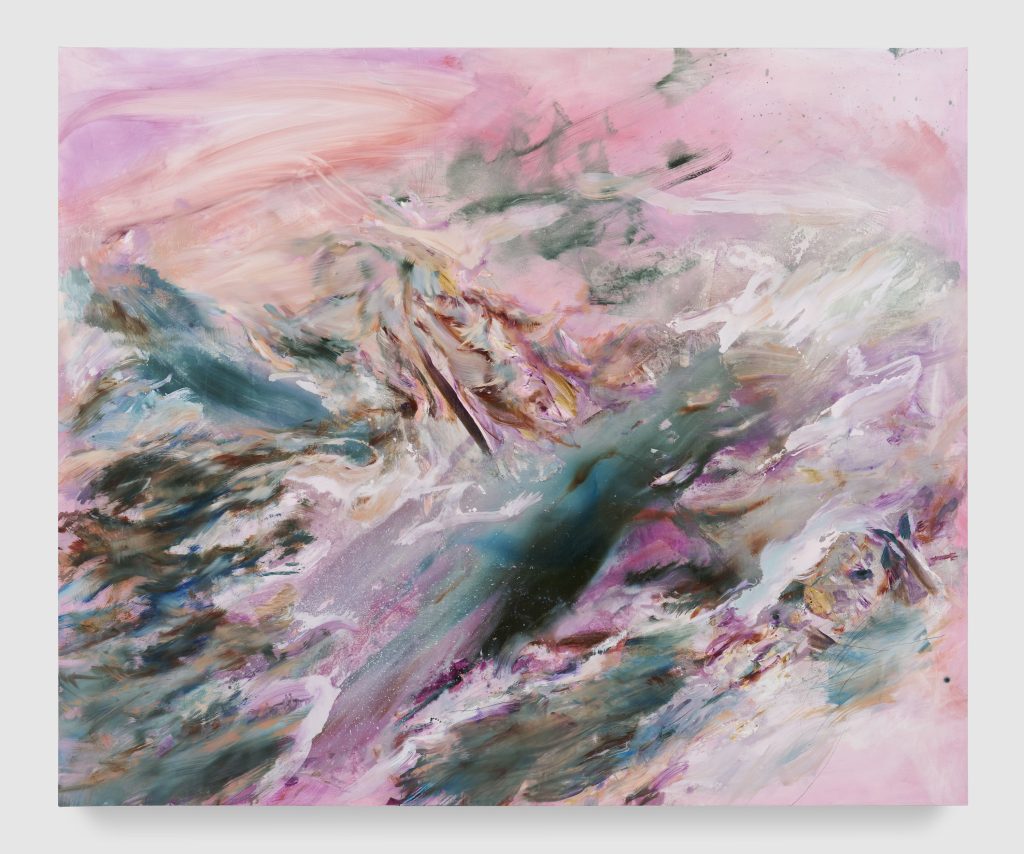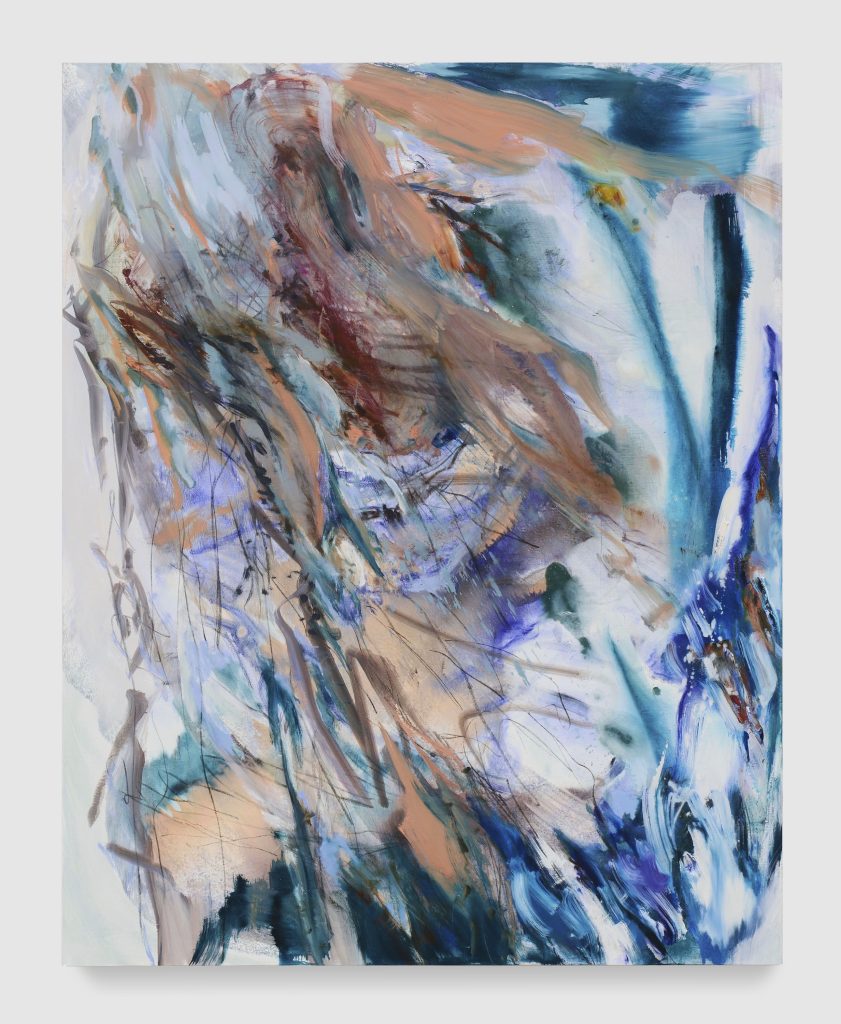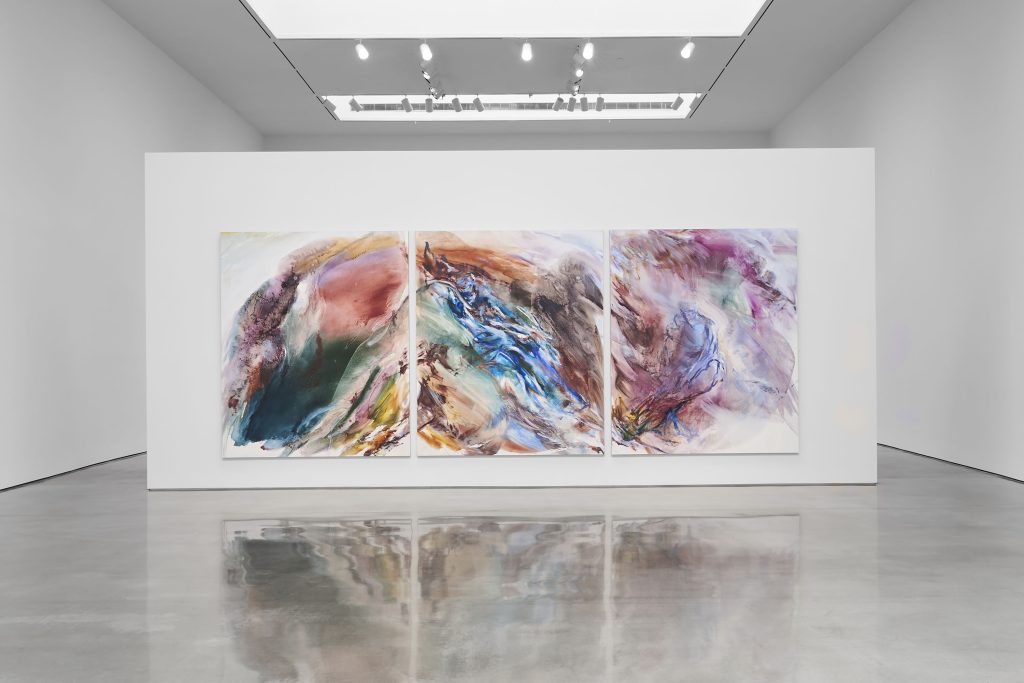Brooklyn-based artist Kylie Manning’s enrapturing paintings in a new exhibition at Pace in New York hold movement and point to more of it: movement that’s spread and sensed across many glances and glimpses that together are shining.
It’s neither an obvious nor a directly explained place that the movement in these paintings is going, but the journey across the exhibition is rich with the enlivening desire that drives that kind of thing ever developing into a grander fullness in the first place. In the world of these artworks, you don’t know and can’t see where the path is leading — both emotionally and literally across the art’s surfaces, which focus more on the aesthetically materialized place in front of you than a sequential, outwardly moving progression. But you still want to go — a want that you can feel and carry even within entirely self-contained moments in which the scene and you within it are not moving outwards. But in some sense, the movement — the spirit of the thing — is still happening, and still accessible. There is still real hope.
There’s a sensory blanket of want, of placement, of love, and longing in the leaps and bounds and spins that Manning’s applications of color take across her surfaces. You feel the intertwining and interweaving indications of material movement as steeped in personhood, as reflective of and carrying the formidable weight of want. Even as that grows across Manning’s paintings, the impression remains monumental and present, like a pulsing heart culminating in each of the movements of color that we’re looking at.
And you really feel that the swirling colors themselves and the non-tangible areas of life that they reflect are a key, establishing presence. It’s all given its due.
The paintings blend abstraction with the figurative, with an individualized indication of a person’s form reappearing… sometimes only in part… amid thickets and waves of color. The overall accumulations of color and form remind me of places in the natural world, like a waterfront or a forest, though these too are not strictly, directly represented. I more think of how what we’re looking at in that kind of place tends to be massive, interwoven, formidable, and inexplicable: the remainder of a process or many processes that started well before we ever arrived and that any single one of us in isolation would find it difficult to explain in anything other than an estimation. But! We know it works. We know it grows and that it moves and that it’s alive. We’re looking at the evidence.
The poignant, voracious color palette of Manning’s paintings was created in part with “local minerals,” the gallery explains, including tourmaline, calcite, and quartz, which amplify a grounded feeling.
Here, you get a distinct sense it’s all alive, transcending the bounds of what we know as conscious life and even outside the organic. It’s all… teeming. As Manning’s colors seem to not stop moving at just about any cognizable point amid any of these exhibited artworks, it’s all… movement, and the movement — the streaks and flashes of color swinging across these artworks — it all builds to such a point that it feels like a refreshed vision of what in reality is a simple, straightforward concept in how we all individually access it each and every day: being alive.
I feel these brief moments combining fragility and voraciousness, as found in a moment of real-life movement that perhaps in that exact form will never happen again. Yet, I feel these moments somehow continue, or at least become elevated — leaving a lasting impression. Here, those instances retain themselves and remain.
The fluctuating areas of color across each of Manning’s artistic surfaces somehow make the intangible — like an impression of an individual’s presence — into something just as active and internally alive and real and lasting as the physical environment around that kind of thing. It says that someone was here and in some ways still is.
The art materializes the unreal, putting the imagined, the felt, and the wanted on a level of recognition alongside the more familiarly formed. And if anything, that wistful, ambitious, and hopeful perspective becomes the leading one in the show.
It’s a state of immersive transformation, a place of consistent elevation. Even in its fleeting, fluttering nature, the movement is just as real and weighted as the body and space from which it comes. The quiet hope is here expressed as a present and physical force.
And looking back at a couple of these paintings as I finish up, I’m struck by a key element. Though what’s within each painting does not invoke familiar, three-dimensional space, they are relentlessly lit. The lightness — both of form and as a presence and feeling of actual light emanating from within and washing across each artwork — is consistent to the point that the light becomes a given.
“Kylie Manning: There is something that stays” is on view through April 19 at Pace in New York City.



Featured image:
Kylie Manning: There is something that stays
510/540 West 25th Street, New York, NY 10001
March 14 – April 19, 2025
Photography courtesy Pace Gallery
You may also like
-
Diana Kurz at Lincoln Glenn in New York: A Review of a Shining Art Exhibition
-
Dustin Hodges at 15 Orient in New York City: An Ensnaring Exhibition at an Exciting Gallery
-
Maren Hassinger at Susan Inglett Gallery in New York: Reviewing an Uplifting Art Exhibition
-
Enzo Shalom at Bortolami in New York City: Reviewing an Entrancing Exhibition of Paintings
-
“Ben Werther: Townworld” at Amanita in New York City: Reviewing a Richly Memorable Art Exhibition
